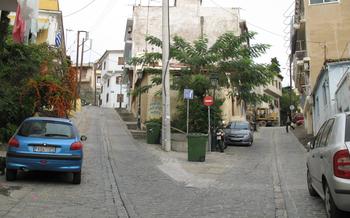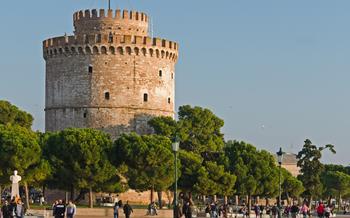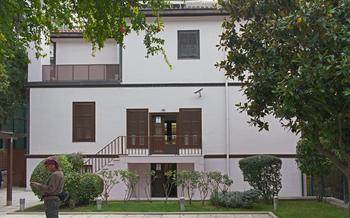
Thessaloniki's Old Railway Station
- Thessaloniki's Old Railway Station: Symbol of Architectural Heritage
- The Birth of the Station: A Journey Back in Time
- A Majestic Facade: Admiring the Station's Exterior
- A Thriving Transportation Hub: Witnessing the Station's Bustling Past
- The Station's Transformation: Embracing a New Purpose
- The Railway Museum: A Journey Through Time
- A Cultural Venue: Embracing the Station's New Identity
- The Station's Surroundings: Exploring the Neighborhood
- The Station's Architecture: A Reflection of Thessaloniki's History
- A Symbol of Resilience: Overcoming Challenges and Adversity
- The Station's Role in Local Life: A Community Gathering Place
- A Destination for History Buffs and Architecture Enthusiasts
- The Station's Contribution to Urban Development: A Catalyst for Progress
- Insider Tip: Uncovering Hidden Stories and Secrets
Thessaloniki's Old Railway Station: Symbol of Architectural Heritage
Thessaloniki's Old Railway Station, a magnificent architectural masterpiece, stands as a symbol of the city's rich heritage and cultural significance. Constructed in the late 19th century, the station played a pivotal role in shaping the city's development and connecting it to the rest of Europe. Today, it stands as a testament to the city's resilience and its commitment to preserving its architectural treasures.
Historical Significance: The station's historical significance lies in its role as a gateway to the city and a vital transportation hub during the late Ottoman period and the early 20th century. It witnessed the arrival and departure of the legendary Orient Express, linking Thessaloniki to major European cities and facilitating cultural exchange and economic growth.
Architectural Style: The station's architectural style is a fusion of Neoclassical and Art Nouveau elements, showcasing intricate details and elegant lines. Its imposing facade, adorned with decorative moldings and sculptures, reflects the grandeur and opulence of the era in which it was built.
Location and Accessibility: Situated in the heart of Thessaloniki, the station is conveniently located within walking distance from many of the city's main attractions. Its proximity to the city center, the vibrant Ladadika district, and the waterfront promenade makes it easily accessible to visitors and locals alike.
The Birth of the Station: A Journey Back in Time
Thessaloniki's Old Railway Station owes its existence to the vision and ambition of the late 19th century. In 1873, the construction of the station commenced, a project that would forever change the city's transportation landscape. The station was designed to serve as a crucial stop along the iconic Orient Express, a legendary train line that connected Europe's major cities.
The Orient Express, with its luxurious carriages and opulent dining cars, symbolized the glamour and allure of rail travel. Its arrival in Thessaloniki marked a new era of connectivity and cosmopolitanism for the city. The station became a bustling hub of activity, welcoming passengers from all corners of Europe and beyond.
The construction of the station not only facilitated travel but also played a pivotal role in the development of Thessaloniki. The city, once a sleepy provincial town, began to emerge as a major commercial and cultural center. The station served as a gateway for trade and commerce, connecting Thessaloniki to markets across the region.
With the arrival of the Orient Express, Thessaloniki embraced its role as a crossroads of cultures. The station became a meeting point for people from diverse backgrounds, fostering new connections and stimulating intellectual exchange. It was here that the city's vibrant cultural scene began to flourish, attracting artists, writers, and intellectuals from across the globe.
A Majestic Facade: Admiring the Station's Exterior
Thessaloniki's Old Railway Station stands out with its grand and elaborate facade, embodying the architectural spirit of the late 19th century. Designed in a distinctive Neoclassical style, the station boasts a symmetrical composition and intricate detailing that captivates the eye.
The exterior of the station is adorned with elegant pediments, decorative moldings, and ornate friezes, showcasing the skill and artistry of its creators. The main entrance features a monumental portico supported by imposing columns, inviting visitors to step into the grandeur that lies within.
Above the main entrance, an elaborate clock proudly displays the time, reminding travelers of the station's crucial role in connecting people and places. The clock's intricate design and gold-leafed hands add a touch of timeless elegance to the station's facade, symbolizing its enduring presence in the city's history.
The station's exterior is not merely an aesthetic marvel; it also serves a functional purpose. The large windows that line the facade allow ample natural light to flood into the interior, creating a bright and welcoming atmosphere for passengers.
Overall, the exterior of Thessaloniki's Old Railway Station is a testament to the architectural prowess of its era and sets the stage for the grandeur that awaits visitors as they step inside.
A Thriving Transportation Hub: Witnessing the Station's Bustling Past
In its heyday, Thessaloniki's Old Railway Station was a bustling transportation hub, teeming with life and activity. The arrival and departure of trains were a daily spectacle, as locomotives huffed and puffed, releasing clouds of steam that filled the air. The station's platforms were a symphony of sound and motion, with the clatter of wheels on tracks, the shouts of conductors, the greetings and farewells of passengers, and the hustle and bustle of baggage handlers.
Crowds of travelers from all walks of life thronged the station, eager to embark on their journeys. Businessmen in tailored suits, families with young children in tow, and adventurous backpackers with maps in hand all converged within these walls. The station was a place of dreams and possibilities, where people from different cultures and backgrounds crossed paths, creating a vibrant tapestry of human interaction.
As the trains pulled in and out, the station served as a gateway to distant lands. Passengers bound for far-off destinations boarded their carriages, filled with anticipation and excitement. The station was a place where goodbyes were said and promises were made, where new adventures began and old memories were left behind.
The Station's Transformation: Embracing a New Purpose
As the decades passed, the golden age of rail travel began to fade. The rise of air travel and the increasing popularity of automobiles led to a decline in passenger traffic at Thessaloniki's Old Railway Station. The station gradually fell into disuse and was eventually closed in the 1970s, leaving it abandoned and neglected for many years.
The closure of the station was a significant loss for the city. Not only did it mark the end of an era of transportation, but it also left a gaping hole in the urban fabric of Thessaloniki. The once-bustling station was now a desolate and forgotten relic of the past.
But the story of Thessaloniki's Old Railway Station did not end there. In the early 2000s, a group of dedicated citizens and preservationists came together to save the historic building from demolition. They recognized the station's cultural and architectural significance and launched a campaign to restore and revitalize it.
Through their tireless efforts, the station was eventually restored to its former glory. The exterior was meticulously cleaned and repaired, and the interior was renovated to create a modern and functional space while preserving its original character. The station was finally reopened to the public in 2009, marking a new chapter in its storied history.
The Railway Museum: A Journey Through Time
The Thessaloniki Railway Museum, housed within the Old Railway Station, offers a captivating journey through the history of Greek rail transport. Dedicated to preserving and showcasing the rich heritage of the station and the role of railways in shaping the country's development, the museum presents an array of fascinating exhibits and interactive displays.
Visitors are greeted by a collection of preserved locomotives and carriages, meticulously restored to their former glory. These impressive machines, once the workhorses of the Greek railway system, stand as testaments to the ingenuity and engineering prowess of their time. Interactive displays and hands-on experiences bring the history of the station and the railways to life, allowing visitors to immerse themselves in the sights, sounds, and sensations of a bygone era.
Through engaging storytelling and multimedia presentations, the museum delves into the construction and operation of the Thessaloniki Railway Station, highlighting its significance as a gateway to the city and a catalyst for economic growth. Visitors can learn about the station's role in the development of tourism and trade, as well as its impact on the social and cultural fabric of Thessaloniki.
A Cultural Venue: Embracing the Station's New Identity
Thessaloniki's Old Railway Station has undergone a remarkable transformation, evolving from a bustling transportation hub to a vibrant cultural venue. The station's spacious halls and grand interiors now host a diverse range of cultural events, showcasing the city's vibrant arts scene.
Art exhibitions, featuring both local and international artists, adorn the station's walls, transforming it into a gallery of contemporary expression. Performances of theater, music, and dance fill the air with creativity, bringing the station's historic spaces to life. Concerts, from classical to rock and beyond, resonate through the halls, attracting music lovers from all corners of the city.
The station's new identity as a cultural venue has breathed new life into its historic structure. It has become a hub for artistic expression, a place where people can gather to experience and celebrate the diversity of Thessaloniki's cultural offerings.
The Station's Surroundings: Exploring the Neighborhood
Thessaloniki's Old Railway Station is not just a landmark in itself, but it also serves as a gateway to the city's vibrant Ladadika district. Once a bustling commercial hub filled with warehouses and merchants, Ladadika has undergone a remarkable transformation into a vibrant neighborhood teeming with charming streets, independent shops, trendy cafes, and inviting restaurants.
As you step out of the station, the cobblestone streets of Ladadika unfold before you, inviting you to explore its hidden gems. Admire the restored 19th-century buildings that line the streets, each with its own unique story to tell. Discover charming boutiques showcasing local crafts and one-of-a-kind souvenirs. Indulge in the flavors of traditional Greek cuisine at tavernas and ouzeries serving mouthwatering dishes and local delicacies.
Don't miss the opportunity to visit the nearby Kapani Market, a bustling bazaar where vendors sell everything from fresh produce and spices to handmade goods and antiques. Immerse yourself in the vibrant atmosphere as you haggle for the best prices and soak up the local culture.
For a taste of Thessaloniki's rich history, explore the nearby landmarks such as the White Tower, the city's iconic symbol, and the Rotunda, an ancient Roman monument that has stood the test of time. Let the stories of Thessaloniki's past come alive as you wander through these historic sites.
As the sun sets, Ladadika transforms into a vibrant nightlife destination. Bars and clubs come alive with music, laughter, and the infectious energy of the city. Whether you prefer live music performances, dancing the night away, or simply sipping cocktails while enjoying the lively atmosphere, Ladadika has something to offer every night owl.
The Station's Architecture: A Reflection of Thessaloniki's History
The Thessaloniki Old Railway Station stands as a testament to the city's rich and diverse history, reflected in its eclectic architectural style. The station's design incorporates elements from various periods and cultures, showcasing the city's complex past. The station's facade, with its symmetrical lines and intricate carvings, is a prime example of Neoclassical architecture, popular in Europe during the 19th century. The arched windows and rounded columns lend a sense of grandeur and elegance to the station's exterior.
The station's interior is equally impressive, featuring high ceilings, spacious halls, and intricate tile work. The stained-glass windows, depicting scenes from Greek mythology and history, add a touch of color and artistry to the station's interior. The station's clock tower, a prominent feature of the station's facade, is a symbol of precision and punctuality, essential elements in the operation of any railway station. The station's exterior and interior seamlessly blend various architectural influences, creating a unique and captivating landmark that reflects Thessaloniki's diverse cultural heritage.
A Symbol of Resilience: Overcoming Challenges and Adversity
Thessaloniki's Old Railway Station has stood as a resilient symbol, weathering the storms of wars and economic crises. During the Balkan Wars and World War II, the station fell victim to destruction and neglect. Yet, it rose from the ashes, restored to its former glory thanks to the tireless efforts of the local community.
In the face of economic hardships, the station faced the threat of closure and demolition. However, the people of Thessaloniki rallied together, recognizing its cultural and historical significance. Through their unwavering determination and advocacy, they successfully preserved this beloved landmark, ensuring its legacy for generations to come.
The story of Thessaloniki's Old Railway Station is a testament to the power of resilience and community spirit. It stands as a reminder that even in the face of adversity, with perseverance and unity, we can overcome challenges and safeguard our heritage for the future.
The Station's Role in Local Life: A Community Gathering Place
The Thessaloniki Old Railway Station has played a significant role in the lives of the local community. It has served as a gathering place for people from all walks of life, fostering a sense of unity and shared experiences. Throughout history, the station has hosted various events, including celebrations, protests, and public gatherings. It has witnessed the coming together of people to mark important occasions, express their views, and engage in community activities. The station's presence has created a sense of place and belonging, making it an integral part of the local social fabric. Even today, the station continues to be a beloved landmark, evoking nostalgic memories and serving as a symbol of the city's rich history and cultural heritage.
A Destination for History Buffs and Architecture Enthusiasts
Thessaloniki's Old Railway Station is a treasure trove for history buffs and architecture enthusiasts. Its rich past, eclectic architectural style, and impressive restoration make it a must-visit attraction for anyone interested in exploring the city's heritage.
Step inside the station and be transported back in time as you admire the intricate tile work, stained glass windows, and grand staircases. Every corner of the building reveals a story, from the majestic facade to the hidden treasures within.
For history enthusiasts, the station's museum offers a fascinating glimpse into the role it played in the development of Thessaloniki. Learn about the arrival of the Orient Express, the bustling crowds of travelers, and the station's contribution to the city's economy and culture.
Architecture enthusiasts will be captivated by the station's eclectic style, which blends Neoclassical, Art Nouveau, and Ottoman influences. Admire the intricate carvings, decorative moldings, and the iconic station clock, which has become a symbol of Thessaloniki's architectural heritage.
Whether you're a history buff, an architecture enthusiast, or simply someone who appreciates beautiful buildings, Thessaloniki's Old Railway Station is a destination not to be missed. Immerse yourself in its rich history, admire its architectural splendor, and discover the stories that lie within its walls.
The Station's Contribution to Urban Development: A Catalyst for Progress
The Thessaloniki Old Railway Station played a pivotal role in shaping the city's landscape and urban development. Its construction marked the beginning of a new era for Thessaloniki, connecting it to the rest of Europe and facilitating trade and travel. The station acted as a catalyst for economic growth, attracting businesses and industries to the surrounding area. The development of the Ladadika district, once a warehouse district, into a vibrant commercial and cultural hub was largely influenced by the station's presence. The station's transformation into a cultural venue further contributed to the city's urban regeneration, attracting visitors and creating a vibrant atmosphere in the neighborhood. Today, the station stands as a testament to the power of preservation and regeneration, demonstrating how historic landmarks can be repurposed to serve new functions and contribute to the city's progress.
Insider Tip: Uncovering Hidden Stories and Secrets
To truly immerse yourself in the history and essence of Thessaloniki's Old Railway Station, take the time to engage with locals and uncover the station's untold stories. Many residents have personal anecdotes and memories związany with the station, whether it's tales of long-lost journeys, hidden compartments, or secret wartime activities.
Explore the station's hidden corners and secret passages to discover its unique charm and character. There may be forgotten rooms, abandoned platforms, or even old railway equipment that offer a glimpse into the station's rich past.
By delving deeper into the station's secrets, you'll gain a richer understanding of its significance and the role it has played in the lives of the people of Thessaloniki. It's in these hidden stories and details that the true spirit of this historic landmark comes to life.




